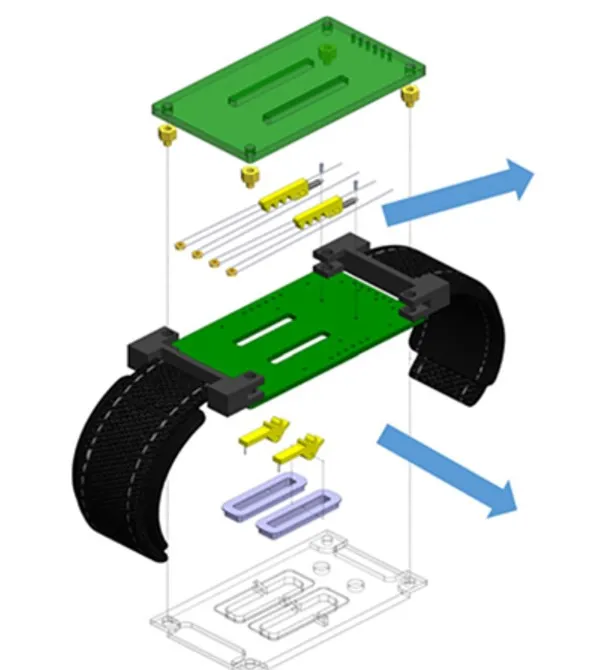A Blood-Monitoring Device Inspired by Mosquitoes
The e-mosquito is a continuous glucose-monitoring device that could help people with diabetes better manage their blood sugar
:focal(301x177:302x178)/https://tf-cmsv2-smithsonianmag-media.s3.amazonaws.com/filer/57/db/57db7e93-3554-46ea-b474-f19528954000/prototype.jpeg)
The mosquito is responsible for more deaths than any other animal on earth, thanks to its habit of spreading diseases like malaria and dengue fever. But studying the mosquito’s bloodsucking jab might just help scientists save lives at risk from another disease: diabetes.
Researchers at the University of Calgary in Canada have developed an “e-mosquito,” a device that pierces the skin like a mosquito’s mouthparts and extracts a tiny amount of blood from a capillary to use for glucose testing. Embedded in a watch-like band, the e-mosquito can be programmed to automatically prick the skin multiple times a day and analyze the results, relieving people with diabetes of the need to test their blood glucose in the traditional way, by sticking their finger and wiping the blood on a test strip. People with diabetes have to monitor their blood sugar levels carefully; people with type 1 diabetes sometimes prick their fingers up to eight times a day.
“The idea is to get rid completely of finger-pricking and the logistics around finger-pricking, which are really bothersome,” says Martin Mintchev, the senior researcher on the project. “For children, in particular, and the elderly, and blind people, this is a very cumbersome exercise several times a day.”
Mintchev and his team have been working on the e-mosquito for a decade. The material they originally used for the actuator – the part of the device that moves the needle – made it large and bulky. But the invention of a new material called shape memory alloy, a composite metal that contracts or expands with electric current, proved a boon. A tiny amount of shape memory alloy can provide a strong force, which allowed the team to miniaturize the device to its current watch-like size.
“It can penetrate the skin with much greater force, and greater controllability, and a minimal use of electricity,” Mintchev says. Plus, like a mosquito bite, it's almost painless.

The current prototype consists of a “watch” top with the actuator, a battery, and LED display and several other components, with an attached bottom cartridge with the needle and test strips. Though the current prototype fits on the wrist, in theory the device could be strapped almost anywhere on the body. There will be challenges before the device is ready for the market, though. Right now, while the e-mosquito can reliably hit a capillary, it doesn’t always bring enough blood to the surface for testing. In this sense, it’s truly similar to a mosquito, which rarely leaves behind a pool of blood on the surface of the skin. Mintchev and his team could equip the device with a larger needle, but that would defeat the idea of the device being tiny and painless. So what they hope to do instead is develop a needle that doubles as a sensor. The needle would penetrate the skin and the sensor would check the blood while still embedded, then transmit the results wirelessly.
“The technology of today has the ability to do this,” Mintchev says. “It requires a bit more work from us, of course.”
They’re also interested in seeing whether the device can work alongside an artificial pancreas, a device which continuously and automatically monitors glucose levels and delivers insulin. The first artificial pancreas was approved by the FDA last year; Mintchev and his team wonder if the e-mosquito technology could somehow be combined with newer models to provide better continuous monitoring.
Mintchev says a consumer-ready e-mosquito might be on the market in as little as three years, depending on FDA approval. Right now he estimates the cost of using the device as about twice as much as using traditional finger-pricking and glucose strip technology. But with time that cost may go down, he says.
“I’m sure that when mass produced it will become really competitive to traditional finger pricking,” he says.
A device that helps people with diabetes eliminate finger-pricking has been something of a holy grail for scientists. Many people with diabetes need to test their glucose every few hours, even during sleep. Apple is said to be secretly conducting feasibility trials of an optical sensor that can measure glucose levels noninvasively by shining a light through the skin, reportedly pouring hundreds of millions of dollars into the project. Google is working on its own continuous glucose monitor. But developing successful continuous glucose-monitoring devices, invasive or not, is a notoriously difficult endeavor. A former diabetes industry consultant, John L. Smith, has written an entire book on the failures of various continuous glucose-monitoring technologies, in which he describes tiny needle technologies like e-mosquito as “[a] recurrent technological theme” that has been tried many times over the years but has yet to bear fruit.
For the sake of the 1.25 million Americans with type 1 diabetes, here’s hoping the e-mosquito has a more successful outcome.
/https://tf-cmsv2-smithsonianmag-media.s3.amazonaws.com/accounts/headshot/matchar.png)
/https://tf-cmsv2-smithsonianmag-media.s3.amazonaws.com/accounts/headshot/matchar.png)